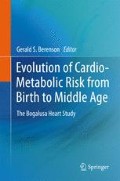Abstract
The widespread occurrence of adult cardiovascular diseases in westernized populations, coronary artery disease, hypertension and diabetes mellitus, and the evidence these begin in childhood show the need to begin prevention early for virtually everybody. Damaging lifestyles learned early have to be addressed through education. The background from pediatric epidemiologic studies over the past four decades stresses approaches for prevention should be through primordial prevention. This can best be done through comprehensive and coordinated health education of school children. However, the challenge remains with respect to incorporating a sufficient health education program into the school systems that serve the entire population of children. Our experience shows single focused prevention efforts, e.g. for smoking, or for drugs, or for alcohol, are not as effective as broad health education, just like medical care is the ideal approach that physicians try to use in general medical practice. Thus, there is a need to get the parents and education community along with the communities of business and health care involved. Health education or prevention programs spearheaded by programs outside of the traditional educational system fail once the funding of such programs disappears. Failures also occur because general health is not part of the traditional education process and teachers are not trained in this discipline. Federal, state, and local governments will have to support school systems to begin and sustain such programs over time. Meeting this challenge is the best hope for primordial prevention.
Access this chapter
Tax calculation will be finalised at checkout
Purchases are for personal use only
References
American Heart Association Scientific Statement (2003) AHA Guide for improving cardiovascular health at the community level. Circulation 107:645–651
Chen W, Srinivasan SR, Li S, Xu J, Berenson GS (2005) Metabolic syndrome variables at low levels in childhood are beneficially associated with adulthood cardiovascular risk: the Bogalusa Heart Study. Diabetes Care 28:126–131
National Center for Chronic Disease Prevention and Health Promotion (2008) Characteristics of an effective education curriculum. School Health Education Resources (November 2008)
Brenner ND, McManus T, Foti K, Shanklin SL, Hawkins J, Kann L, Speicher N (2008) Characteristics of health programs among secondary schools. School Health Profile 2008. Centers for Disease Control and Health Promotion, Atlanta
Owen S (1980) When the student is ready the teacher will come: a perspective on health education. J S Carolina Med Assoc 76:16–20
Berenson GS et al (1998) Introduction of comprehensive health promotion for elementary schools: the Health Ahead/Heart Smart Program. Vantage Press, New York
Nader PR, Perry C, Maccoby N, Solomon D, Killen J, Telch M, Alexander JK (1982) Adolescent perceptions of family health behavior: a tenth grade educational activity to increase family awareness of a community cardiovascular risk reduction program. J Sch Health 52:32–37
Downey AM, Greenberg JS, Virgilio SJ, Berenson GS (1989) Health promotion model for “Heart Smart”: the medical school, university and community. Am J Health Promotion 13:31–46
Downey AM, Frank GC, Webber LS, Harsha DW, Virgilio SJ, Franklin FA, Berenson GS (1987) Implementation of “Heart Smart”: a cardiovascular school health promotion program. J Sch Health 57:98–104
Downey AM, Cresanta JL, Berenson GS (1989) Cardiovascular health promotion: “Heart Smart” and the changing role of the physician. Am J Prev Med 5:279–295
Downey AM, Virgilio SJ, Serpas DC, Nicklas TA, Arbeit ML, Berenson GS (1988) “Heart Smart”—a staff development model for a school-based cardiovascular health intervention. Health Educ 19:64–71
Berenson GS, Srinivasan SR, Fernandez C, Chen W, Xu J (2010) Can adult cardiologist play a role in prevention of heart disease beginning in childhood? Methodist Debakey Cardiovasc J 6:4–9
Nicklas TA, Johnson CC, Farris R, Rice R, Lyon L, Shi R (1997) Development of a school-based nutrition intervention for high school students: Gimme 5. Am J Health Promot 11:315–322
Virgilio SJ, Berenson GS (1988) Superkids-Superfit: a comprehensive fitness intervention for elementary schools. J Phys Educ 59:19–25
Johnson CC, Nicklas TA, Arbeit ML, Harsha DW, Mott DS, Hunter SM, Wattigney W, Berenson GS (1991) Cardiovascular intervention for high-risk families: the Heart Smart Program. South Med J 84:1305–1312
Berenson, GS, Harsha DW, Johnson CC, Nicklas TA (1993) Teach families to be heart smart. Patient Care 6:135–145
Arbeit ML, Johnson CC, Mott DS et al (1992) The Heart Smart cardiovascular school health promotion. Behavior correlates of risk factor change. Prev Med 21:18–32
Berenson GS (2010) Cardiovascular health promotion for children: a model for a Parish (county)—wide program (implementation and preliminary results). Prev Cardiol 13:23–28
Kuntzleman CT (1985) Instructors guide for feelin’ good. Fitness Finders, Spring Arbor
Mott DS, Virgilio SJ, Warren BL, Berenson GS (1991) Effectiveness of a personalized fitness module on knowledge, attitude and cardiovascular endurance of fifth-grade students: “Heart Smart”. Percept Mot Skills 73:847–858
Author information
Authors and Affiliations
Corresponding author
Editor information
Editors and Affiliations
Rights and permissions
Copyright information
© 2011 Springer Science+Business Media B.V.
About this chapter
Cite this chapter
Berenson, G.S., Owen, S. (2011). Primordial Prevention Through School Health Promotion. In: Berenson, G. (eds) Evolution of Cardio-Metabolic Risk from Birth to Middle Age:. Springer, Dordrecht. https://doi.org/10.1007/978-94-007-1451-9_14
Download citation
DOI: https://doi.org/10.1007/978-94-007-1451-9_14
Published:
Publisher Name: Springer, Dordrecht
Print ISBN: 978-94-007-1450-2
Online ISBN: 978-94-007-1451-9
eBook Packages: Biomedical and Life SciencesBiomedical and Life Sciences (R0)

